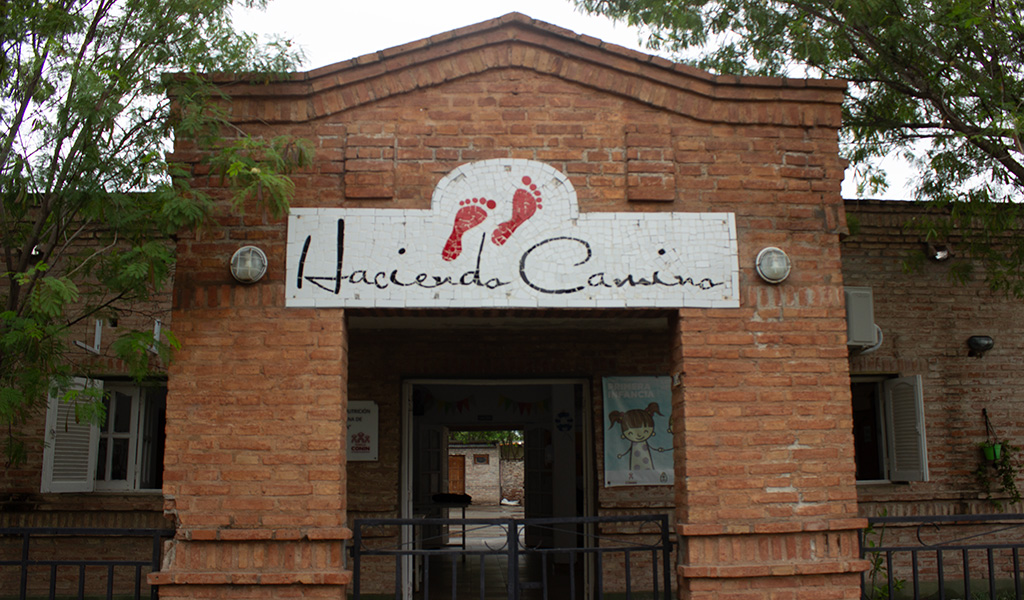In rural Argentina, Hacienda Camino offers parents a suite of skills and resources to help raise healthy children.
Support stories that are silenced elsewhere. Donate to our nonprofit newsroom.
A weary rhythm marks the passing hours among the humble dwellings on the dirt streets in Herrera, a town of about 2,000 people 150 kilometers (93 miles) from the Argentinian province’s capital of Santiago del Estero. I have only been in this town for a short time, but the question that will hang over the next 48 hours is already appearing: How does one raise a child in the midst of poverty?
The context is challenging: According to the Ministry of Health of Santiago del Estero, 31.1% of children under 5 in the province suffer from chronic malnutrition. At the same time, poverty among children between 0 and 14 years of age is 56.2%, according to 2023 data from the National Institute of Statistics and Census (INDEC).
Housing is precarious, many residents lack access to drinking water or sanitation, and unemployment and under-employment abound. “My husband is away on a trip,” say almost all the women I visit. Most of the men are seasonal workers: They are hired seasonally by rural companies in other provinces and leave their homes and families for several weeks at a time.
“The combination of comprehensive care of the child by specialized professionals and the training of the mother in daily care is the best strategy for the psychomotor recovery and the recovery of the children’s weight and height,” says Gabriela Rao, who leads early development for the NGO Haciendo Camino.
Haciendo Camino has 12 centers in Santiago del Estero and Chaco, two of Argentina’s poorest provinces. Last year, 1,646 children (most under age 5) received comprehensive care and 2,947 children underwent growth controls. In addition, 1,413 mothers participated in health education talks, received family support, and were empowered to become agents of change in their communities. Of these mothers, 120 attended the center located in Herrera.
More than two years passed between when Demir was in his mother’s womb and the day he received his nutritional discharge. During that time, his mother, Cinthia Farias, age 31, regularly took him to the Haciendo Camino center in Herrera, where the organization works with mothers of children suffering from malnutrition. There, Farias learned about the importance of incorporating vegetables, fruits, and proteins in her son’s diet and how to establish a bond with him focused on his needs through play.
“I made my baby’s first baby blanket and changing table at the Haciendo Camino center. They also taught me how to breastfeed and start feeding him. I learned things I didn’t know with my first daughter, Ivana, like avoiding sodas and juices and instead giving her lots of fruits,” she tells me as she leaves her consultation with nutritionist Greta Willi, who also suggested that Demir start eating with a plate more similar to the rest of the family.

“We took an integrated care model from CONIN, the Argentine foundation dedicated to combating child malnutrition. That is, providing nutritional assistance with social support and a focus on early development. We noticed that it worked for the mothers to have spaces such as handicraft or education workshops in addition to coming for check-ups,” says Cecilia Lecolant, director of the Herrera center, after making rice pudding for the afternoon snack during a break in the early education at home program’s biweekly meeting.
“The Haciendo Camino programs aim to provide nutritional treatment and accompany the families in their homes,” adds Natalia Fernández, who leads the nutrition program.
During the 3-hour program, participants learn practical aspects of parenting at home. This afternoon, Lecolant leads the workshop. She proposes that they make posters to prevent childhood accidents based on their own experiences. One idea they came up with is keeping medicine out of children’s reach.
About 19 women are usually invited to each meeting, and about 12 attend, most of them in their 20s and 30s.
“Once the nutrition program was up and running with the integrated methodology, we noticed that even families with children without malnutrition wanted to stay connected,” says Lecolant.
Haciendo Camino thus added the early education at home service, which follows a logic similar to that of nutrition but with a greater emphasis on promoting positive parenting, a set of practices centered on respectful treatment and adapted to children’s interests.
Beatriz Gómez, 26, has a shyness that is not seen in any of her three children: Sebana, age 8, Valentina, 6, and Gael, 2. They play in and around the house, surrounded by chickens. Gómez attended the Haciendo Camino Center with the three of them. She works cleaning a church, and her partner assembles bags of charcoal in the village when he’s not a seasonal worker.
“I participated in talks and sewing workshops. For example, I learned what to give them when [they are] sick or have a fever. It helped me in the development of my children,” she says. However, not everything started well: “It was hard for me to adapt; I thought they were going to be mean and that they were going to challenge me because my daughter was underweight, that they were going to ask me why I hadn’t taken her [to the center] earlier. But instead, they congratulated me for taking her,” she recalls.
Trust is an important pillar of Haciendo Camino’s work.
“Some [of the women] are waiting to meet you to open up. And it’s good for them when we sometimes open up and tell them things like ‘This happened to me too,’” adds Silvia Burgos. She is one of the leaders at the center in Herrera. “I like how they treat us and what they teach us about how a child should develop. For example, I learned not to sit her down so early,” says Fabiana Maldonado, 33, after reviewing a booklet on baby behavior. Her daughter, Larisa, a year and a half old, sits off to the side looking withdrawn. Maldonado tells us she just stopped breastfeeding.

At Haciendo Camino, many women are able to meet professionals and other mothers whom they can trust. According to an impact evaluation of the NGO’s programs carried out last year by the Argentine Catholic University, “The deficit of social support perceived by the women mothers is greater in the participating group because they do not have someone who can help them in the preparation of meals, they do not have someone to talk to, or to help them with the care of the children.”
Knowing this, the women’s wary (perhaps even fearful) faces make even more sense.
“Mothers lack a lot of knowledge about their rights and those of their children, and we put a lot of emphasis on teaching them that, especially through workshops and talks,” Mendoza says. “For example, we work with many women who suffer gender violence. We try to empower them, show them that it is not normal, and that they should not allow certain situations in their homes.”
In addition to assisting with paperwork (for example, with the municipality, the Health Post, or obtaining subsidies or documents), the social program also works on hygiene and safety habits. Although the program is not exclusively for women, in practice, it is mothers who attend. Fathers usually spend a large part of the day out of the house working, and it is important that mothers take care of their upbringing. “I’m happy that my wife and children go to the center,” Mario, 27, the father of Alejo (6 years) and Neythan (15 months), tells me. He is the only adult male I came across during my visits to the homes of those who attend the center.

Siesta (nap) time has been over for a while, but the peaceful rhythm in the rural area of Herrera is not disturbed as Flavia Pérez, 30, excuses herself and takes a basin with clothes hanging a few meters away. We wait for her, sitting in front of Giovanni, her 6-month-old son, and Romeo, her oldest son, who is 5 years old, with whom Pérez started attending Haciendo Camino.
Valeria Carabajal, the referent in charge of the visit, takes out a bubble box to show to Giovanni. Pérez brings the textured blanket she assembled for her son to sit on the floor. Carabajal teaches Pérez songs and emphasizes the importance of her child looking in the mirror.
“The A-B-C of what we want to transmit at [the early education at home program] is the importance of playing with the children, bonding with the baby, talking to him, and paying attention to his needs. We see progress in families when they have a daily space for play and bonding,” says Lecolant.
“They teach us to play and enjoy the moments with them,” says Marisol Paz, 24, mother of Neythan and Alejo. Meanwhile, Maldonado laughs, saying that her daughter Larisa “looks in the mirror and pretends to be pretty.”
For many, this playful part of parenting is a real discovery. “Many moms have told us, ‘[My parents] didn’t play with me.’ So we have to try to make the idea click and invite them to try how it feels for the child. That’s where the differences are noticeable,” says Lecolant.
“During visits, you sense when there is someone else in the house, especially the mother-in-law,” Burgos tells me. “‘I have raised [children] like this and like that’ is the grandparents’ catchphrase.”
Poverty and under-employment in the area are just some of the challenges in raising children in small towns in Argentina. “On the one hand, perhaps there are recommendations that clash a lot with what the family thinks, and they are not convinced. It’s not that they don’t believe what we propose is correct, but sometimes they seem offended when we insist on some aspects, such as the importance of breastfeeding or a varied diet,” says Lecolant.
Lecolant also points out that at the nutritional level, “Many habits are rooted in the local culture. For example, the iconic food is the stew, which is a response to an economic issue, because you disguise the meal for the whole family with a little piece of meat or some chicken giblets. But perhaps with the same ingredients, you can make a less overcooked dish or use a legume to make it more nutritious. And at snack time, mate cocido (mate tea) with bizcochos(biscuits) is very popular.”
Another challenge for the organization is achieving frequent attendance of mothers at the center. Many are often absent due to their lack of mobility to travel from their homes in remote areas, or the fact that they take care of their children alone.

“These days of humidity make the floor very ugly,” says one mother.
“You can put cardboard on the floor,” says Coria Olivera. She also asks her to create a mobile by hanging different objects so the child can reach them.
“The main lesson they teach you is to adapt to what is available, both in the activities and the meals. Sometimes they ask us to incorporate an ingredient that I don’t have, and they give me ideas to replace it,” Pérez tells me at her home. After hanging up the clothes, she unfolds a blanket for Giovanni to play on.
Gómez shares another example of how the integrated care model takes different forms. “It’s hard for me to do the activities in the booklet because I can’t read or write, but they told me that if I forget, I can send an audio message.”
“We try to make sure that the work with each family is tailored to them. There are no prefabricated recipes of what the family should or should not do. For example, we will not ask them to buy beef every five days. We try to get them to replace these proteins with cheese, eggs, or legumes,” explains Lecolant.
The center’s director also says they sometimes work with other civil and state organizations. For example, the Civil Registry processed ID cards for children who were still undocumented. And the Health Post helped to complete the vaccination schedule for those who are behind on their vaccinations.
Photos stand in for trophies in the office where Willi, the nutritionist, interviews mothers with their children: Photos of the children who were discharged after being admitted with signs of malnutrition, along with the height and weight at which they entered the program and at which they were discharged.
The impact on parenting is, a priori, less quantitatively measurable, says Lecolant.
In 2023, the Argentine Catholic University’s Social Debt Observatory conducted an impact evaluation of Haciendo Camino’s programs. “The programs evaluated have positive effects on structural aspects of a child’s first years of life, such as weight, and developmental aspects such as communication, expression, and problem-solving skills,” says one of the reports from the evaluation.
“Many families point out that the children who participated in the program have an easier time or are more receptive to the activities in kindergarten. Especially those with older children who did not go through the program notice the difference,” says Lecolant. I think of Alejo, Paz’s son, who proudly showed me the medal he received at the end of preschool. His mother told me how what she learned in the Hacienda Camino programs and put into practice had helped the boy to stand out in his classroom.
Participants expressed enthusiasm for Haciendo Camino, according to the reports: “The evaluation in terms of satisfaction with the program is excellent in 33%, very good in 35%, and good in 29%. About 2.6% rated it as fair or bad. What stands out from experience is having learned aspects of baby care and stimulation (81%), issues related to feeding (66%), aspects of baby development (62%), handicrafts (58%), health care (55.6%), and to a lesser extent aspects of hygiene, sex education, and human rights.” What these indicators say is echoed to me by the mothers themselves during our spontaneous conversations.
As we walk with Lecolant along the main street of Herrera, the only paved street in the town, a mother from the early education at home group approaches us and explains to the center’s director that she cannot attend in the afternoon. They agreed that she should come the next day when the mothers from the nutrition group were there. Lecolant emphasizes, “It is very gratifying that the families show such interest in attending.
Hours later, Pérez will summarize why many moms like her choose to maintain the link with Haciendo Camino: “It’s a place where they help us with what each one needs, where we can always come.”
This story was originally published in RED/ACCIÓN (Argentina) and is republished within the Human Journalism Network program, supported by the ICFJ, International Center for Journalists.

For 30 years, YES! Media has been at the forefront of people power, documenting community solutions that will free us all from unjust systems. As we barrel towards a pivotal election, there is a growing need for journalism like ours.
But we need more monthly support to go on.
Only 3 out of every 100 readers donate monthly, and we urgently need more readers like you to donate to keep our journalism alive.
Please join the movement.
Give what you can for the media we need.
Inspiration in Your Inbox
Sign up to receive email updates from YES!




